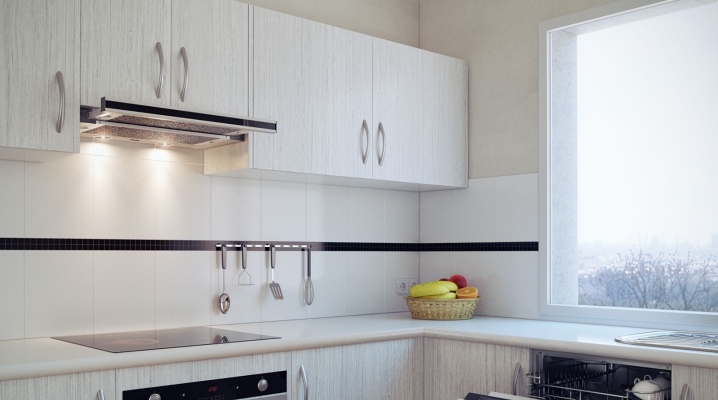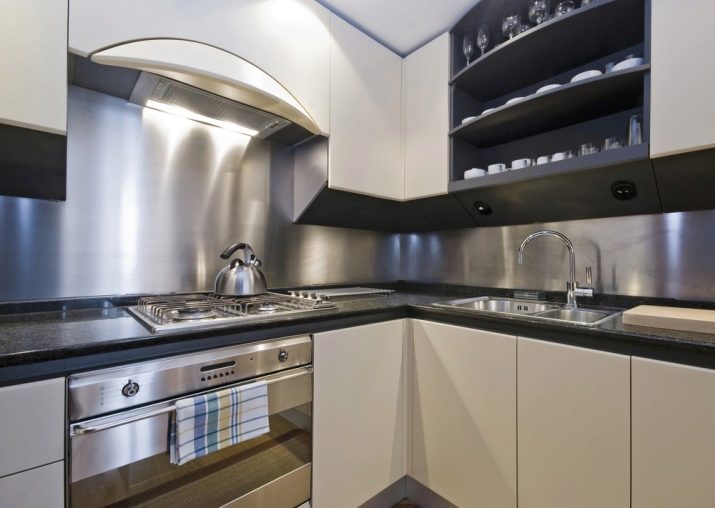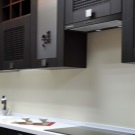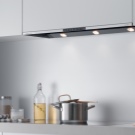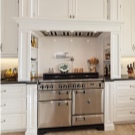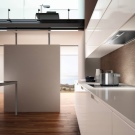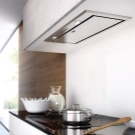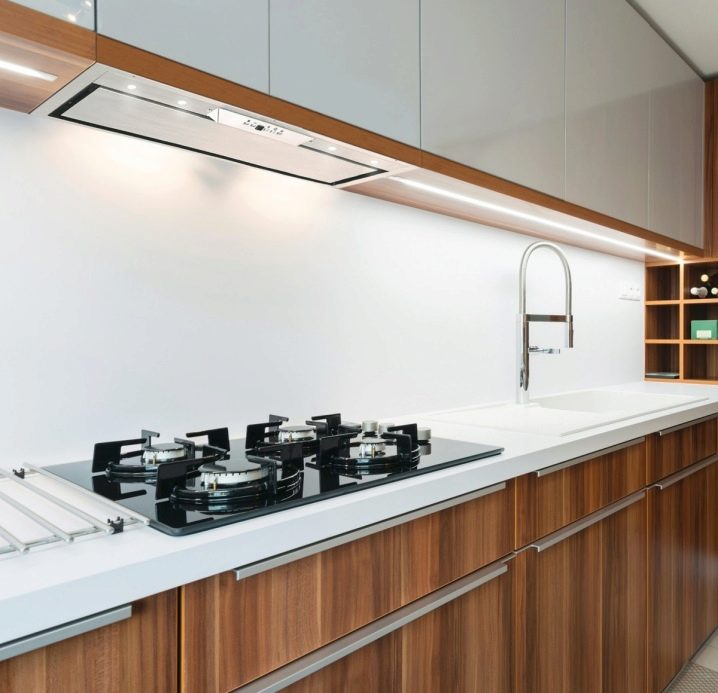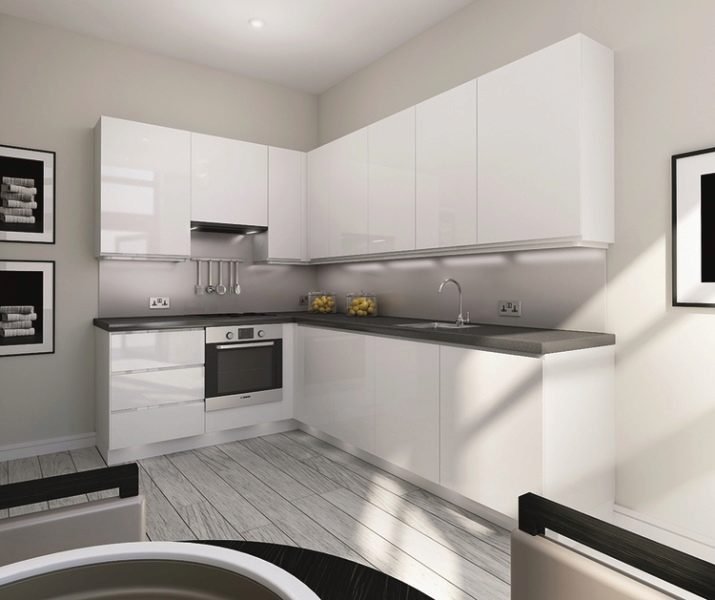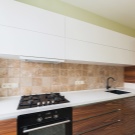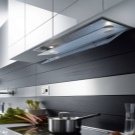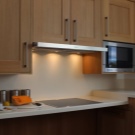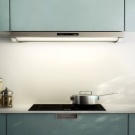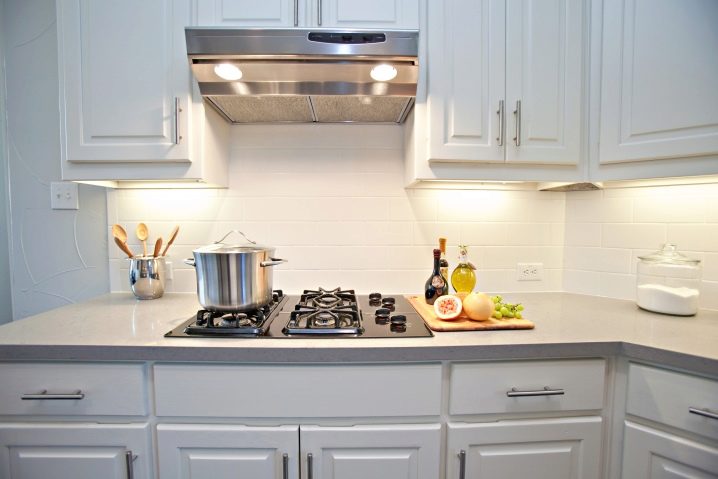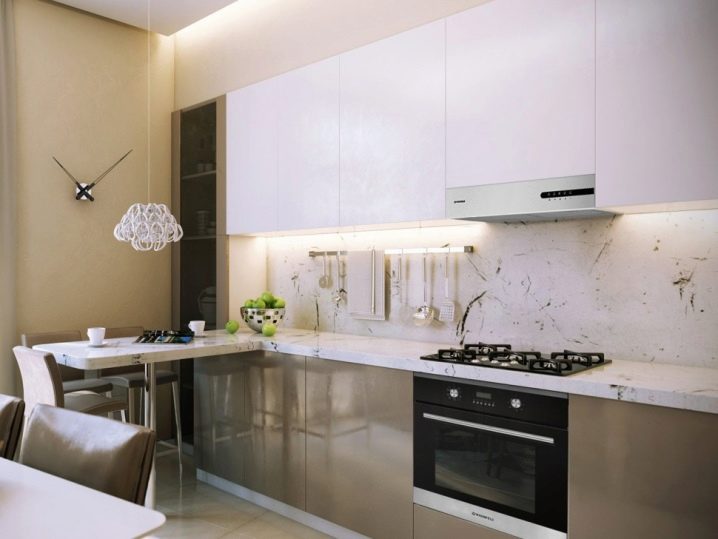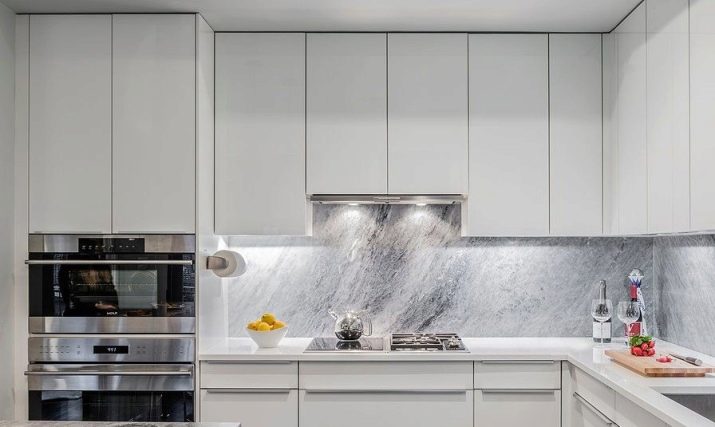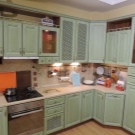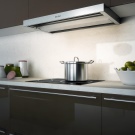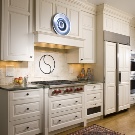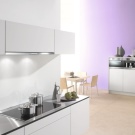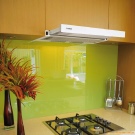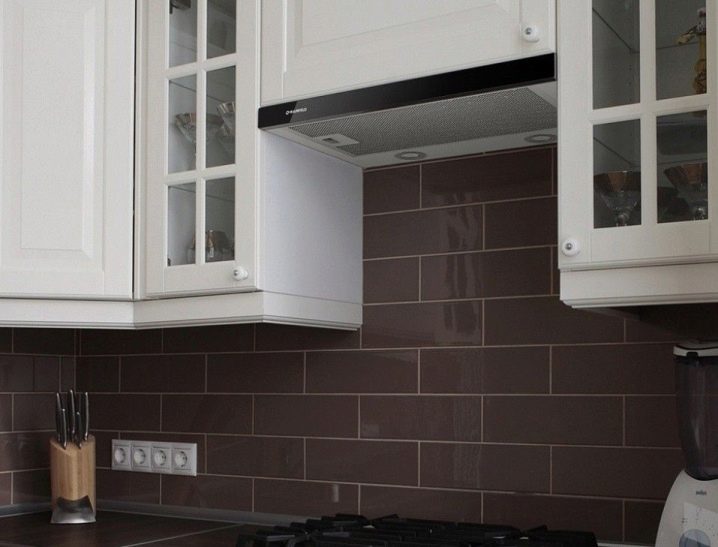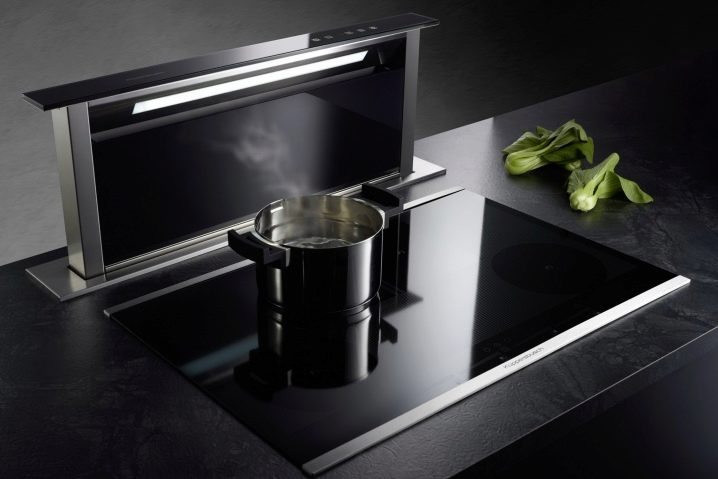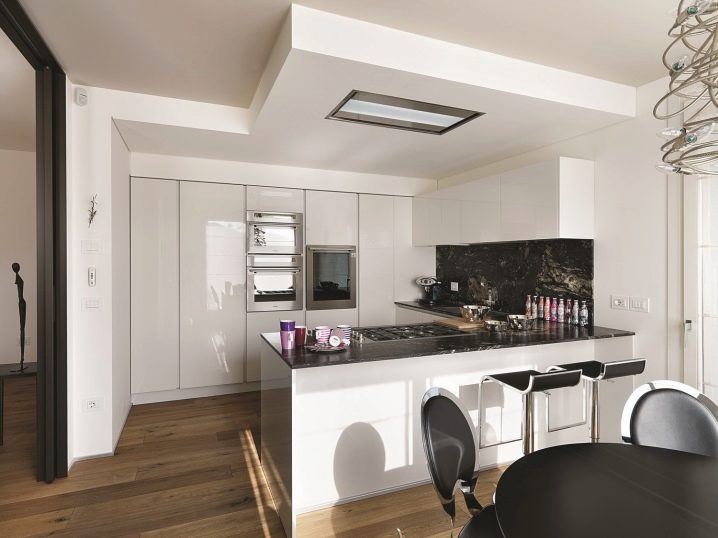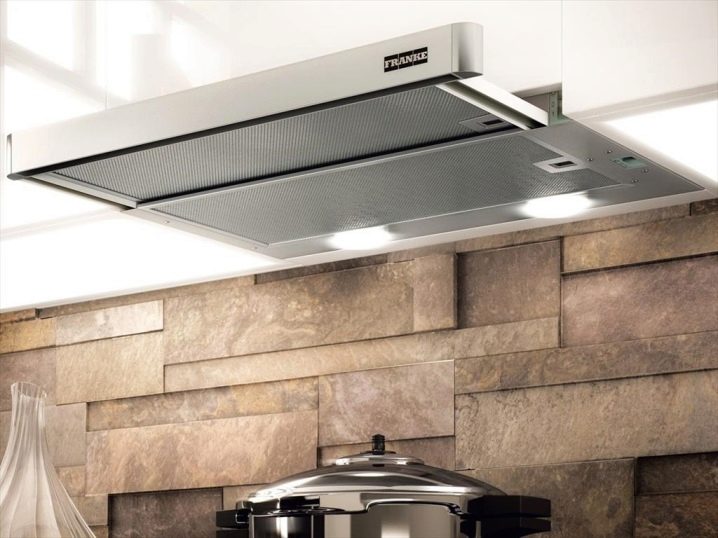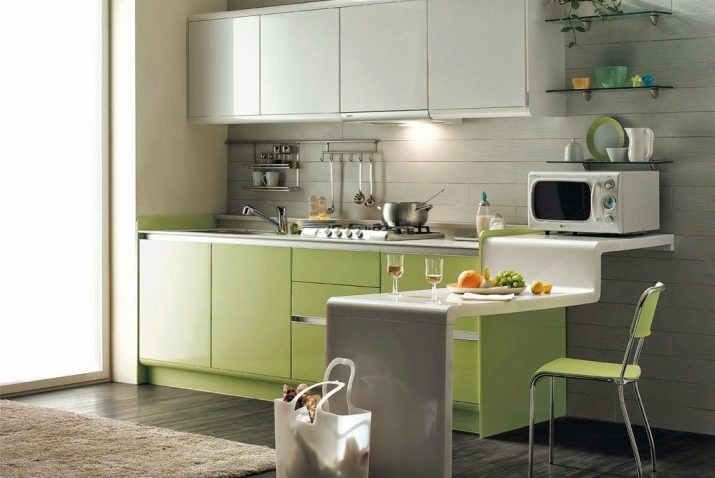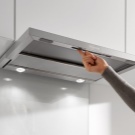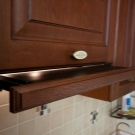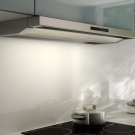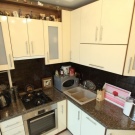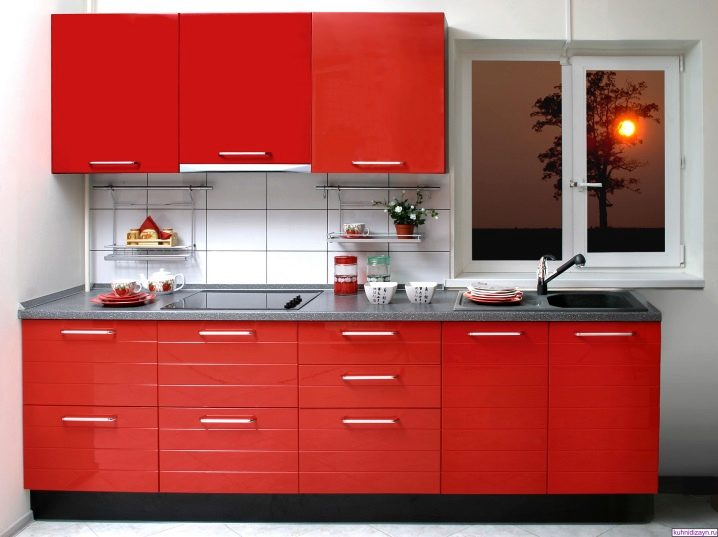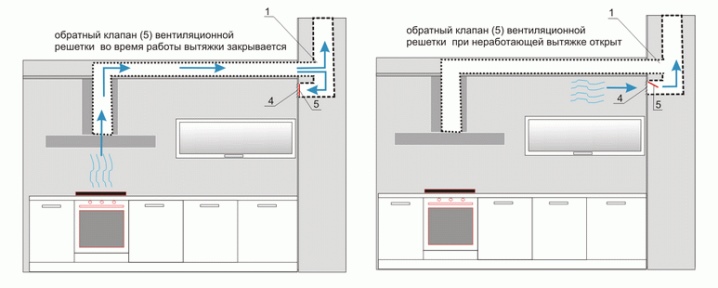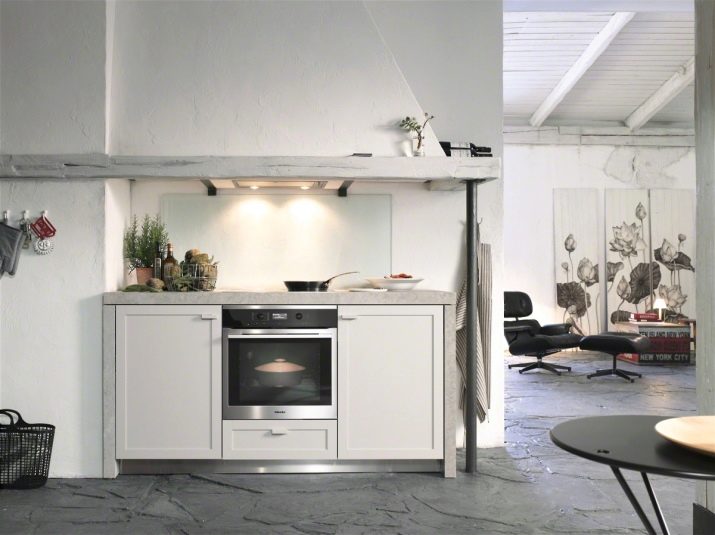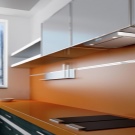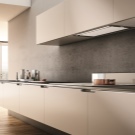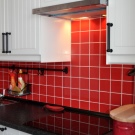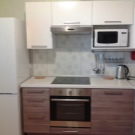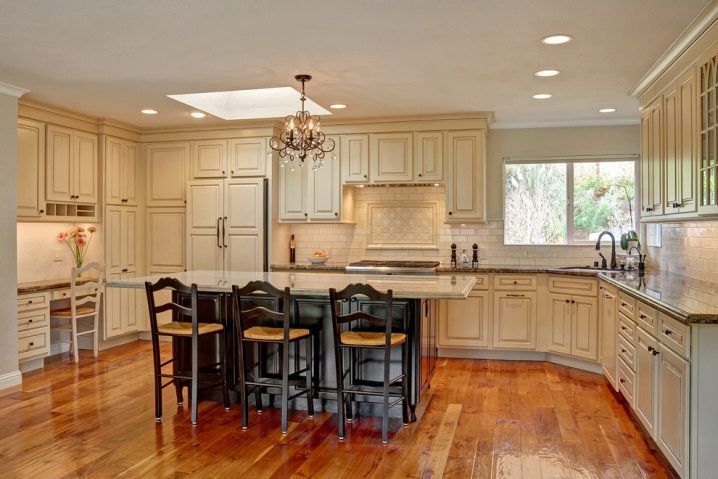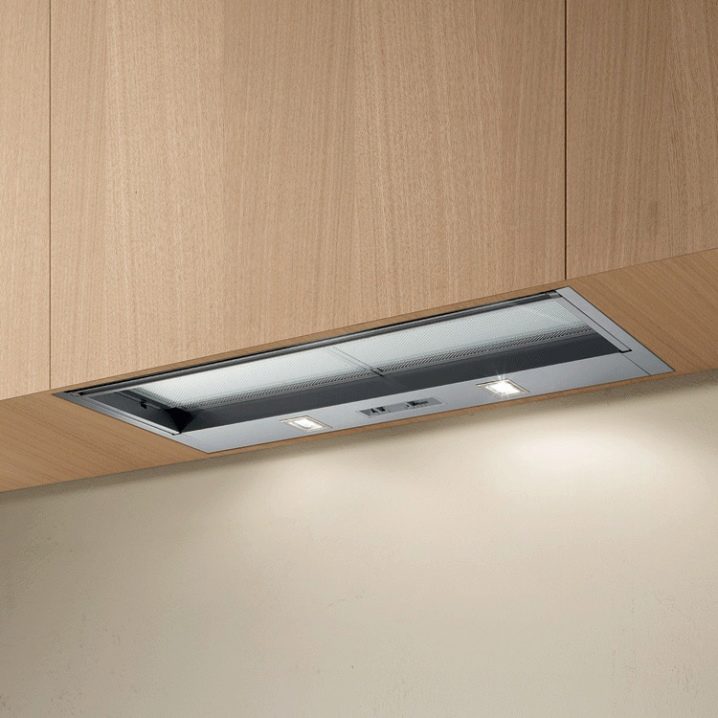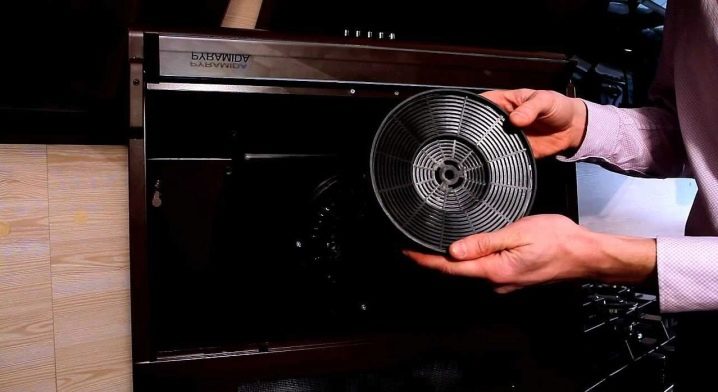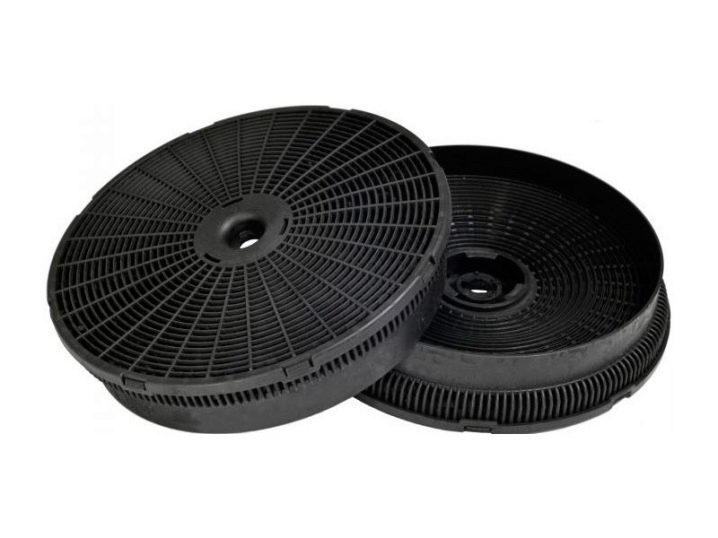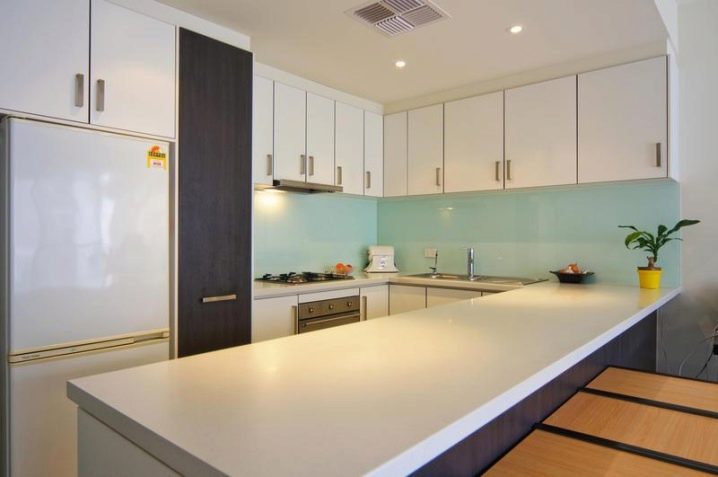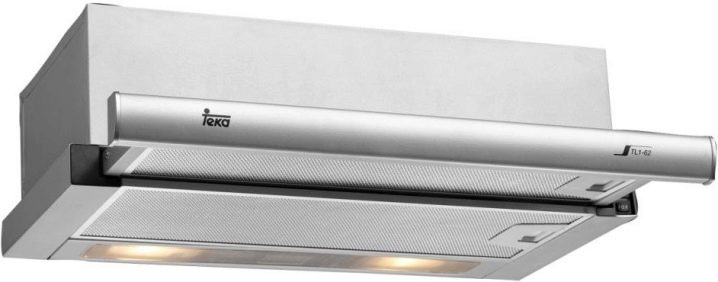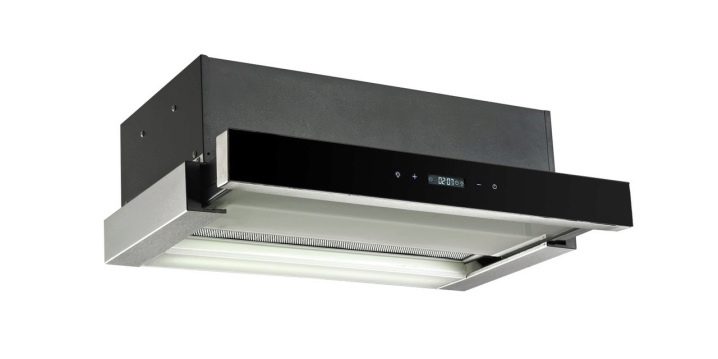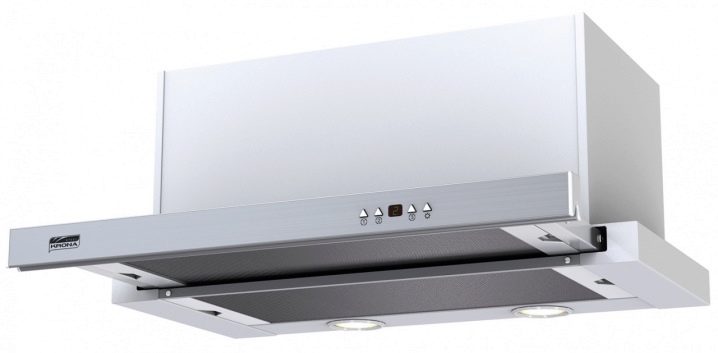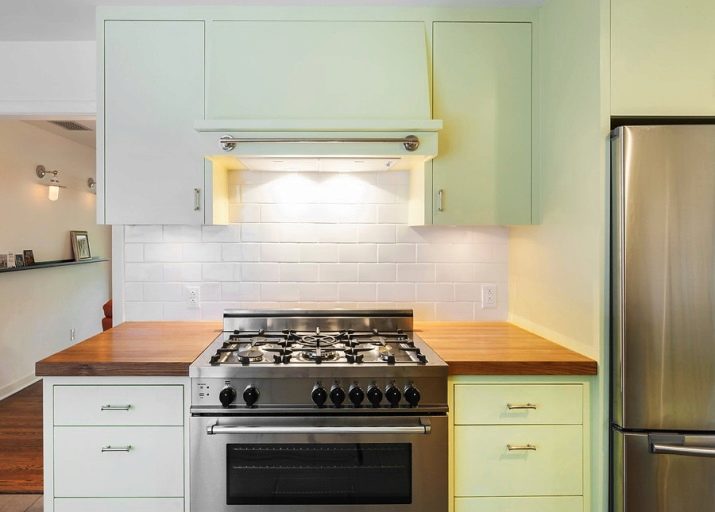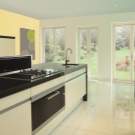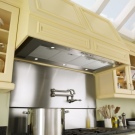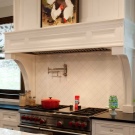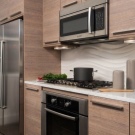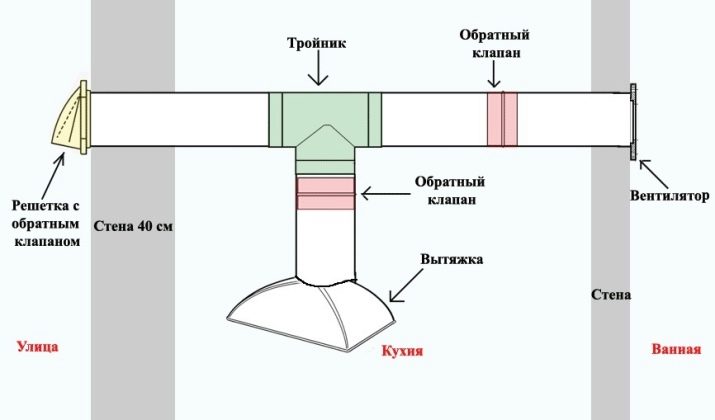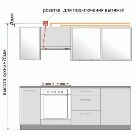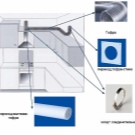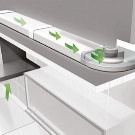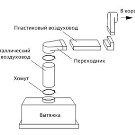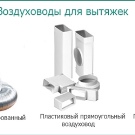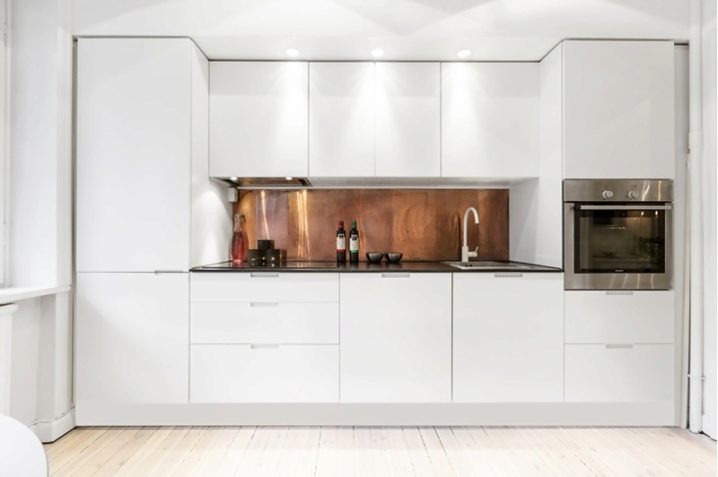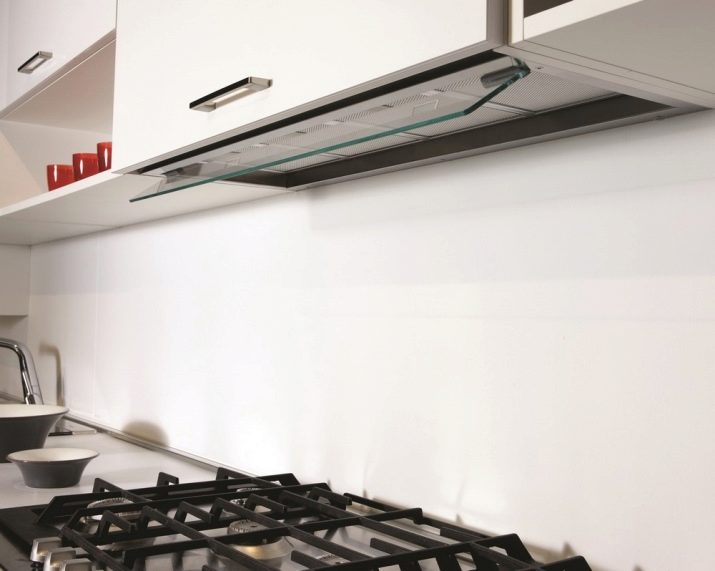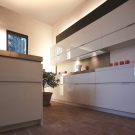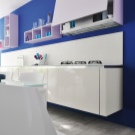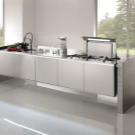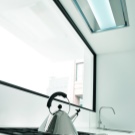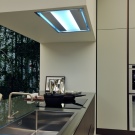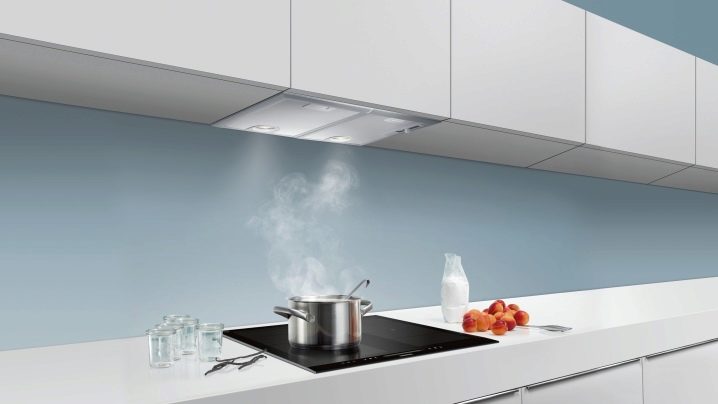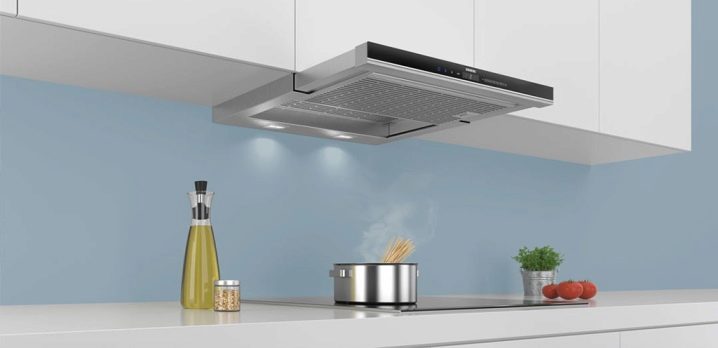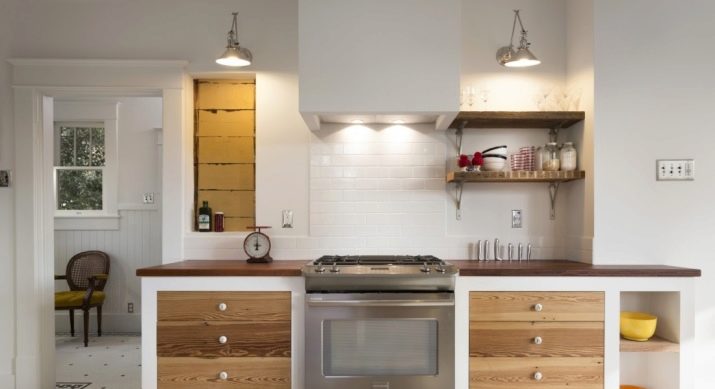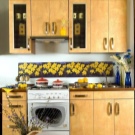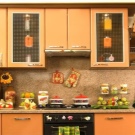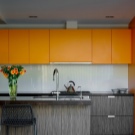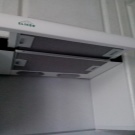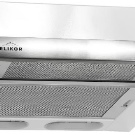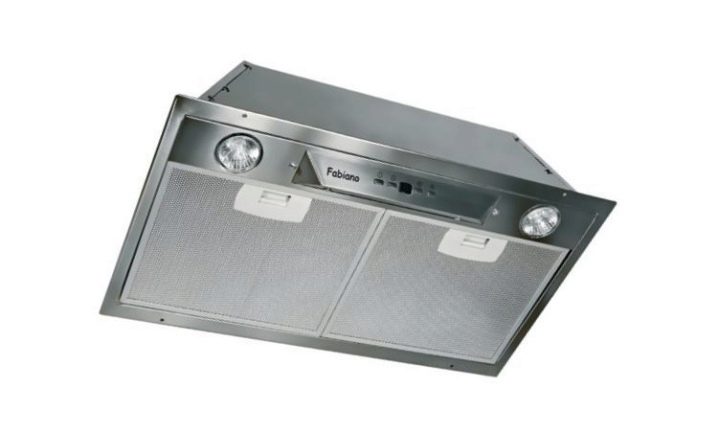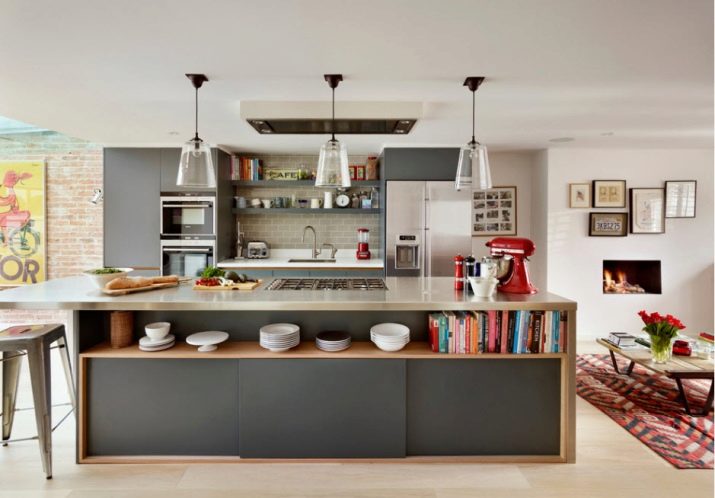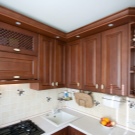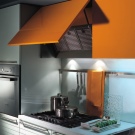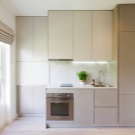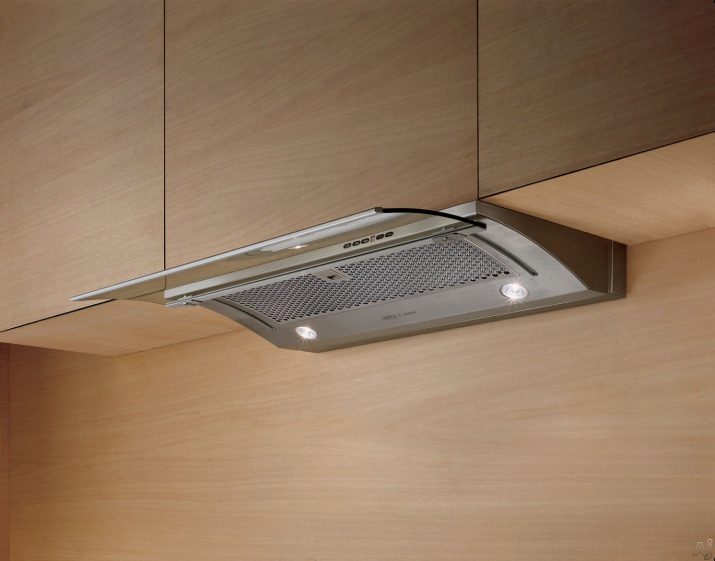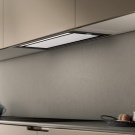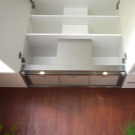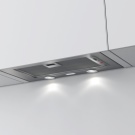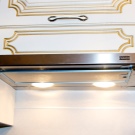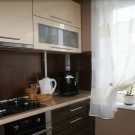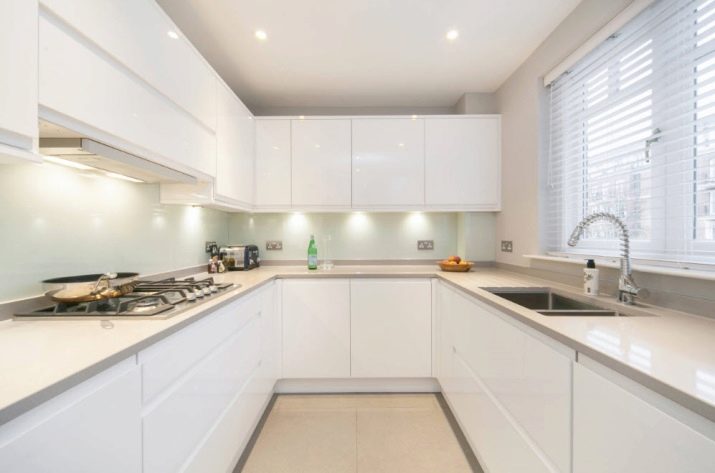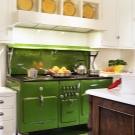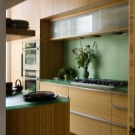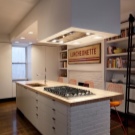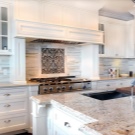Built-in kitchen hood
Virtually no modern kitchen can do without hoods. This accessory not only fits into the interior and sets the style of any kitchen on the type of "high-tech". Its main function is to ensure easy and fast air circulation in the area of the working stove. Thanks to this equipment, all odors are eliminated instantly, not having time to soak the furniture or wallpaper.
Not surprisingly, choosing a hood is not an easy task. We'll have to figure out not only the exterior design, but also the technical characteristics, installation and assembly features, and equipment control. However, it will take quite a bit of time to learn all these subtleties. Practical built-in hoods are particularly popular, so first of all you should pay attention to them.
Advantages and disadvantages to use
It should be noted that analogs of a similar element of an interior practically do not exist.A standard ventilation system equipped in the room is able to provide air circulation, but it will not be quite enough in the case of the kitchen. A quick elimination of vapors and odors is needed, and only specialized equipment can cope with this task.
Despite this, kitchen hoods have their pros and cons, which can be expressed in varying degrees, depending on the model, manufacturer, product quality. What are the advantages of built-in hood options? In general, the following advantages can be distinguished:
- In the case of a built-in hood, only the working surface remains open, that is, its retractable part. Classic options, such as island or dome hoods, look too bulky and stand out from the crowd. In addition, they can take up too much space, while the built-in model is easily hidden in the closet;
- The retractable surface can be adjustable. Most modern hoods are equipped with a sliding panel, so there is always the possibility to increase or decrease the working part;
- Modern technologies allow to make hoods more efficient. Built-in options can be equipped with two or more engines that create a more powerful air flow and increase its circulation. In this case, the engines can be connected to work either automatically or manually if necessary;
- Horizontal built-in hoods save a lot of space in the kitchen. This gives more space for its planning and the possibility of choosing the most suitable design;
- The design and design of such equipment is very simple and concise. Thanks to this approach, they easily fit into any modern interior;
- In most cases, the equipment is equipped with a special aluminum filter., which allows timely catching of fat particles;
The inconvenience is presented except the features of installation and installation of such hoods. It is impossible to say for sure that this is a big minus, however, many nuances will have to be envisaged. For example, it will be necessary to take into account the size and dimensions of equipment when choosing a headset or a kitchen cabinet into which it will be embedded.
Design features
One of the main advantages of built-in hoods is their compact size and ergonomics.Modern technologies made it possible to take the most appropriate design solution, we combine many functions in a fairly simple and convenient form.
Finding suitable dimensions of the working surface is not difficult. Modern manufacturers are fully focused on the standard sizes of kitchens. Find the hood for 50, for 60, 80 or 90 cm. It will not be difficult. Usually there are several variants of the model, which differ only in size.
When choosing a technique you need to focus on the features of its location and work. Most models can be installed according to the type of shelter: between two cabinets or shelves above the stove. The front side of such a simple version is usually hidden behind a special panel, which can be revetted with the same material as the other kitchen set.
Another very popular model - built into the tabletop. It costs relatively more, and its installation may require special skills, so it is easier to contact a specialized service center. A distinctive feature of such extracts is, of course, silent operation.Given that the technique does not emit any extraneous noise, it also demonstrates a fairly high efficiency of air purification.
The option that is most suitable for small-sized kitchens, this, of course, full-built hood. The excess part can be completely cleaned into the cabinet, and the work surface is an almost imperceptible horizontal plane. Most of these models are generally installed directly in the ceiling, but they are only suitable if the height of the kitchen allows the hood to carry out full air circulation over the stove.
Standard retractable hood also saves space. In this case, the work surface can be hidden in the same cabinet or tabletop, which saves free space. If additional ventilation is required, the hood extends over the stove and turns on.
Special attention is given to the so-called telescopic hoods. They are also often called "island" because they are used in large kitchens, where the stove can be located in the center, because of which the hood must be located directly above it,mounted in the ceiling or wall cupboard. Telescopic hoods have the following advantages over other models:
- Demonstrate much higher power., in comparison with other types, including standard dome ones;
- In addition to enhanced airflow, also have a wide area of operation. Of course, due to this, air circulation is much more efficient than in most hoods, even with two or three motors;
- Possess the expressed compactness and ergonomics. Almost all telescopic models are provided for installation in a wall cabinet or ceiling. They are characterized by retractable working panels that easily hide inside and do not take up much space, despite their functionality;
- Perfectly fit into any interior. Due to its conciseness, this technique is suitable for any kitchen design in the style of "high-tech", and can also be used for free experiments.
Perhaps the only drawback is the price. Telescopic hoods, unlike other analogues, are quite expensive. However, this price is fully justified.if you are primarily interested in efficiency, quality and practicality.
When choosing a model, special attention should be paid to its modes of operation. In general, any hood can provide air circulation, or its abstraction. The diversion of air and, consequently, of all odors from the kitchen area implies their discharge to the outside. That is, for the operation of the hood in this mode, you must have a ventilation shaft and access to it.
With such a system, the elimination of odors and vapors is carried out exclusively with the help of air intake and exhaust. If you have access to the ventilation shaft, then this option is quite good, because it does not require the presence of filters, and therefore more economical.
Air circulation hood is easier to install. She does not need access to the mine or to the street, all the inhaled air is returned back to the room, and its cleaning is carried out by special internal filters.
An external metal filter, which is also often made of aluminum, is needed rather for protection. It is used to delay the fat droplets that can get on the surface of the motors and thus over time disrupt the exhaust. Such a filter is easily removed and cleaned manually.using warm water and any suitable detergent.
Much more important are carbon filters. They, as a rule, are located inside the device operating on the principle of air circulation. Carbon filters perform the function of delaying and eliminating odors, that is, cleaning the air as such.
Of course, carbon filters eventually wear out and require replacement. Most modern models of hoods are able to notify about it with the help of indicator lights on the working panel. As a rule, hoods are equipped simultaneously with two filters, that is, protective fat, and coal, which is especially important for the same telescopic options.
Management features
To date, there are only two options for controlling the kitchen hood: mechanical and electronic.
The mechanical type is considered to be the simplest, so it is most often used in the classical versions of technology, while also being very economical. In this case, only a few buttons on the work panel are used. You can manually turn on and off the hood, adjust its power using the mechanical slider, or by separate control of each engine.
As for the models with electronic control type, they are more expensive, however, they attract with their practicality and ergonomics. These hoods are equipped with a small screen with indicators. They can always see the current air temperature, the level of operation of carbon filters or the need to replace them, the level of power of work and other data.
The use of electronic control greatly expands the functionality of the hood and gives it the following advantages:
- The ability to easily and accurately switch multiple modes of operation;
- Notification system;
- Availability of remote control;
- The function of the sensor mode, through which the hood will turn on independently when a certain air temperature over the stove is recorded, or turned off in accordance with the previously set timer;
Hood assembly
It is not enough just to choose the right technique. It must be installed in the interior so that it not only looks appropriate, but also can fully function. How to install the hood yourself? The question is quite complicated, because much depends on the type of equipment,however, it is not enough to know only how this or that model is properly mounted.
The following installation tips can be distinguished:
- If you choose a hood with a discharge mode of operation, then immediately think about what kind of duct is suitable, and where it will be located. Air ducts made of plastic and PVC are lighter and more compact, they fit better into the interior. On the other hand, if you choose an air duct from aluminum corrugations, then it will be much easier to work with it, since it can be given almost any desired shape;
- When choosing a duct, as well as its formation and installation, avoid creating excessive bends. If the duct is too "difficult", it will significantly reduce the force of air traction and, accordingly, the efficiency of the exhaust;
- In addition to the duct, in the case of a variant with a tap, an anti-return mechanism is required. It is installed before going out into the ventilation shaft to prevent the likelihood of backflow of air. If you install a part of the duct inside the cabinet, then you should immediately make a markup for the anti-return mechanism;
- If you have planned a hinged hood, or you want to fix it on the wall, standard dowels are not always suitable. This is especially true if the gas pipe from the tile passes at the place of installation of the equipment. This problem is solved by the acquisition of special mounting screws-studs. They are screwed into the wall almost like standard dowels, but on the reverse side they have adjustable washers that will hold the hood at the right distance from the wall;
- Installing built-in equipment always requires careful pre-marking at the base of the cabinet, in the worktop, on the wall or ceiling. This can be done with the help of contour lines on the box from the equipment that are applied to the production. With their help, you can cut out a “mock-up” that can be placed on any surface to assess the dimensions of the equipment;
Of course, self-installation is not for everyone. Most of all troubles with built-in hoods, so sometimes it is better to turn to specialists who will help solve all the nuances of installing equipment.
Manufacturers Overview
The choice of models of hoods in stores is simply huge.Even if you choose on the basis of your personal inquiries and parameters, the important question still remains: which manufacturer should you trust? In the end, a lot decides the quality of technology. The most popular and reputable manufacturers are the following brands:
Falmec
Falmec is one of the leading Italian companies, the main advantage of which is a unique workmanship. When creating hoods, special steel is used, which is also covered with soundproofing material and is resistant to dust, grease, dirt. The company specializes in embedded and island telescopic hoods, which are always supplied with carbon filters, as well as a more secure attachment to the ceiling and an internal frame that facilitates installation of equipment.
Siemens
Siemens is a company that does not need a big introduction. The hoods of this manufacturer are the best choice for those who appreciate clean air, and also demonstrate high ergonomics and functionality.
The innovative system “Siemens cleanAir” provides the most efficient air recirculation, allowing you to completely abandon the flow-through options of the hoods.
Also, many models of this series are equipped with climate-type sensors that allow you to automatically regulate the switching on and off of engines, their power and duration depending on air temperature and the presence of vapors.
Elikor
Elikor is a modern professional Russian company for the production of household appliances. The products of this manufacturer well combines an affordable price and reliable quality. They are a kind of classic, easily fit into the traditional interior and are suitable for design experiments. Most of the extractors of Elicor have a mechanical control system, which attracts with its simple and reliable. They also stand out against the background of simple installation, since they are always supplied with special brackets that facilitate the installation of equipment on a wall or ceiling.
Fabiano box
The company's products Fabiano Box demonstrates the best performance power. They are ideal for large and spacious kitchens, because their radius of air capture is quite wide. Most models are made of high-quality stainless steel, have panels with pseudo-sensor buttons and have a fairly wide functionality.It includes illumination, the ability to work on a timer, switching between recirculatory and flow-through operation.
Owner reviews
Opinions about the built-in hoods are many. Of course, they are not without their shortcomings. Many owners of recirculating hoods, noting the flaws in their reviews, often associate them not so much with the technology itself, as with its bundling. This may be a small error in the power control or electrical control system as a whole. Also, quite often, there are complaints about the coal filtration system, which rather quickly consumes itself and requires replacement.
In general, if you intend to purchase a hood with air recirculation, you should consider the additional costs of periodically updating the filters. Owners of flow hoods, most often, complain about the fact that their equipment is too noisy.
Most of the modern manufacturers, which we have listed in our article, provided for almost all the nuances in the production of their products. Built-in hood really takes up very little space, demonstrates good work efficiency and rich functionality depending on the model.
Choose the right technique is not difficult.To date, assortments in stores attract attention not only opportunities, but also conciseness. Simple in its design hood is very easy to fit into any version of the interior and can ensure the freshness and cleanliness of the air in your kitchen.
